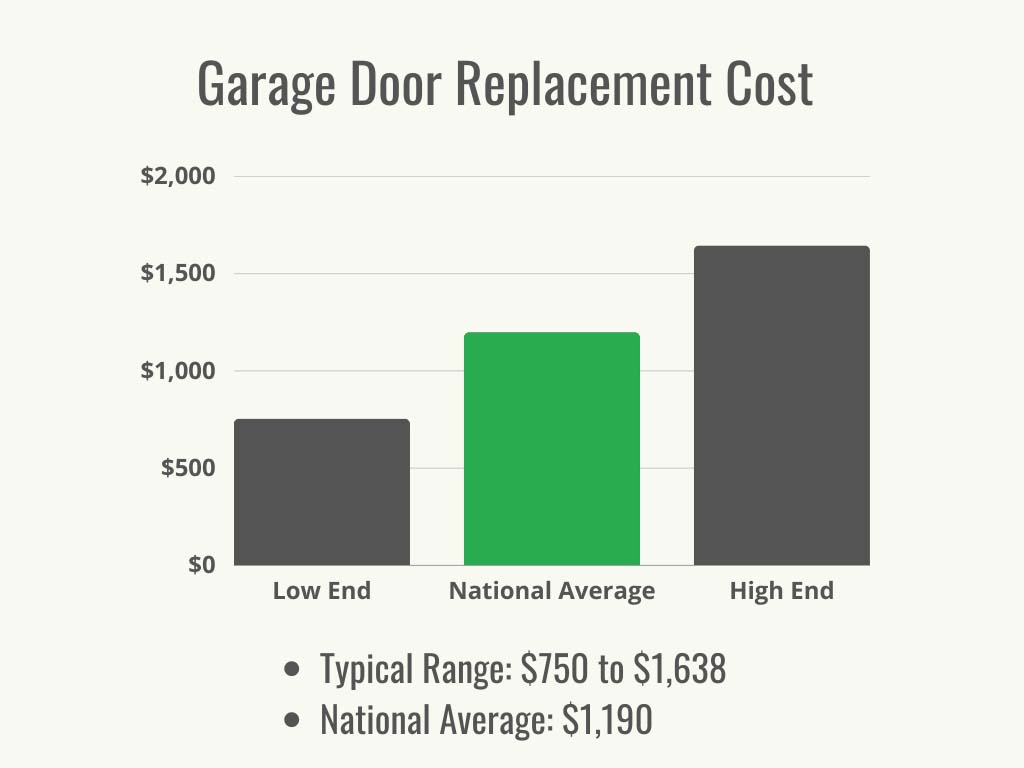We may earn revenue from the products available on this page and participate in affiliate programs. Learn More ›
Highlights
- The cost of garage door replacement is $1,500 to $6,000, with homeowners paying a national average of $2,500.
- The main factors that affect the total cost of this project include the type and size of the garage door, the materials used, the cost of labor, the addition of insulation, and the addition of any customizations.
- It may be time to replace the garage door if a homeowner notices any damage, finds the design unappealing, or wants to upgrade from a manual garage door to an automatic one.
- Installing a garage door is a task best left to the professionals in most cases. Garage doors are heavy and must be properly installed and balanced to prevent any future issues.
Garage doors are more than just an accessory to a home; they offer energy savings, improve curb appeal, and boost property value. If a home’s garage door has seen better days, it’s time for the homeowner to consider getting it replaced to improve the overall aesthetics of their home.
So how much does it cost to replace a garage door? According to Angi, garage door replacement costs range from $1,500 to $6,000 with a national average cost of $2,500, which includes labor and materials. An estimate from one of the best garage door installation companies (such as The Home Depot) will likely include disposal of an existing garage door, hardware replacements, materials, the door, and labor. Homeowners will want to learn about the various factors that can affect garage door replacement costs so they can come up with a realistic budget.

Key Cost Factors
How much does a garage door cost? Garage door installation prices depend on several factors, including removing existing doors, upgrading manual to automatic, labor costs, added features, and location.
Door Size and Type
Garage door prices can vary by size, and door sizes are largely dependent on the garage. A standard garage door is about 7 to 10 feet wide and 7 or 8 feet in height. Adding a single door to a small 1-car garage costs around $500. A 2-car garage might require a double door, which costs up to $5,000. Some homeowners prefer the look of two individual doors instead of a double; however, this will increase the price. Installing three individual doors on a 3-car garage costs between $1,700 and $7,200.
| Garage Door Size | Cost Range |
| 1-car | $500 to $3,000 |
| 2-car, double door | $800 to $5,000 |
| 2-car, two single doors | $1,200 to $4,900 |
| 3-car, one double and two single doors | $1,400 to $7,000 |
| 3-car, three single doors | $1,700 to $7,200 |
The most common and affordable type of garage door is the single panel, which comes in one piece and operates on a hinge system. Tilt-up canopy doors and tilt-up retractable doors have multiple panels and fold away into the ceiling. Sectional garage doors are some of the most popular for their durability, energy efficiency, and attractive appearance, but they come at a higher price point. Lastly, roll-up garage doors that roll into the garage ceiling are the most costly.
Door Material
While the majority of garage doors are made of aluminum, fiberglass, steel, or wood, there are a surprising number of material options on the market. “Steel is the most common option available and offers durability with minimal maintenance required,” says Jon Russell, director of systems at Precision Garage Door Service, a Neighborly company with locations across the country. “Wood provides a genuine carriage-door appearance, but it is considerably more expensive compared to steel doors.” Aluminum is the least costly at $600 to $2,900. Wood costs $900 to $4,500, and steel comes in around $650 to $3,200. Vinyl is a durable material with a moderate price point of around $800 to $2,500. Composite is among the most expensive options, costing between $650 and $4,800.
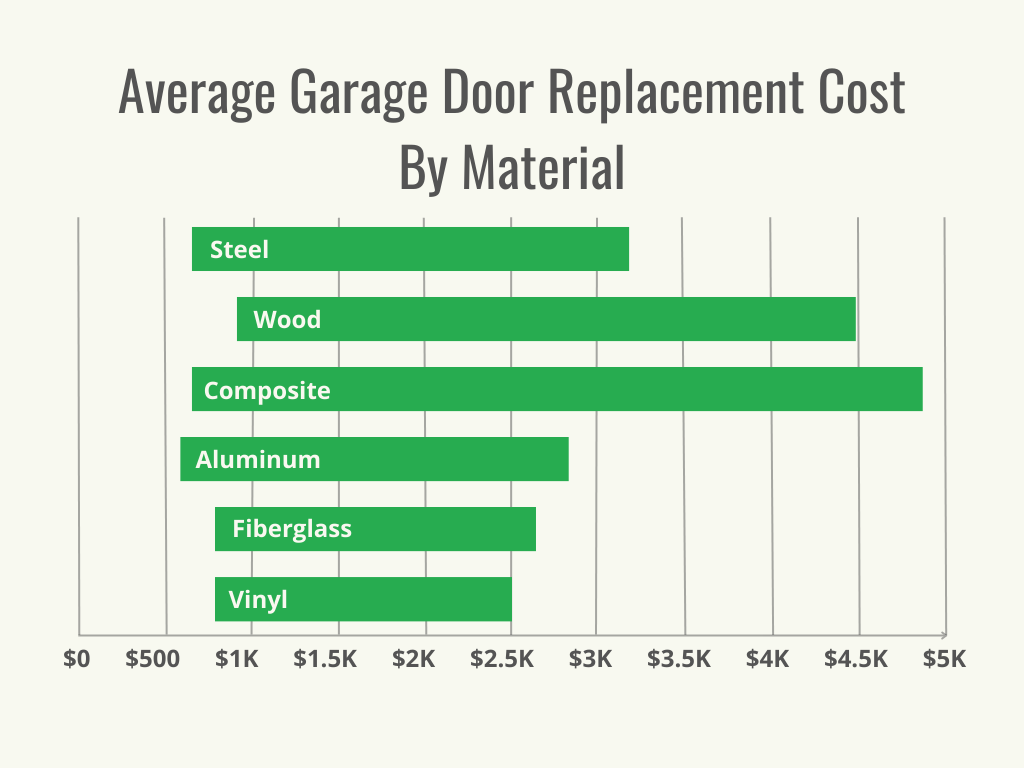
Door Brand
It can be difficult for homeowners to choose from among the best garage doors on the market. Some of the most popular brands are Amarr, C.H.I. Overhead Doors, Clopay, Overhead Door, and Wayne Dalton. Wayne Dalton is the priciest of these at an average cost of $800 to $9,000 for materials, but it’s known for having an impressive variety of styles. On the other hand, Amarr is more affordable at $500 to $1,500 and also carries eco-friendly selections. The average costs for garage doors (materials only) from each of these brands are listed in the table below.
| Door Brand | Average Cost |
| Amarr | $500 to $1,500 |
| C.H.I. Overhead Doors | $600 to $2,000 |
| Clopay | $700 to $3,500 |
| Overhead Door | $750 to $4,000 |
| Wayne Dalton | $800 to $9,000 |
Labor
The labor cost to install a garage door is $350 on average but can range from $200 to $500. The door material does not affect labor costs since they are based on the time it takes to complete installation. Costs can vary by location, so it’s a good idea to look into garage door replacement nearby to see what local contractors are charging.
Additional Costs and Considerations
Garage door replacement cost is driven by a few additional factors depending on the existing structure and the homeowner’s needs. Factors such as replacing missing remote garage door openers, adding insulation, and including additional customizations impact the overall cost of a new garage door. According to Russell, “The best feature would be getting a 24-gauge polyurethane insulated garage door. This makes for a much better door from a structural standpoint. Adding custom straps and handles to the exterior of the door [can enhance the overall look].”
- Replacement vs. repair: Depending on the state of the old garage door, it may make sense for a homeowner to make a few repairs instead of replacing the entire thing. Most garage door repairs cost between $150 and $356, with the most common repairs being to the tracks, garage door roller replacement, or garage door spring replacement. Individual garage door panel replacement is also a relatively common and simple fix.
- Manual vs. automatic: While a manual garage door costs between $600 and $2,150, one that opens automatically costs an extra $200 to $1,300. This includes the cost of garage door opener installation, which is between $220 and $520, and labor. If the old garage door also had an automatic opener, homeowners can expect to pay about $390 for garage door opener replacement.
- Old door removal: In most cases, the old garage door will need to be removed and hauled away. There is typically a disposal fee of about $50 to $200 for this service.
- Resizing: Homeowners may need to increase the height or width of the door if they have a boat or lifted truck. The average cost to resize a garage door ranges from $500 to $2,000, depending on the size and scope of the job.
- Openers: Most homeowners appreciate the convenience of an automatic garage door opener. The average cost for an automatic garage door opener is $220 to $520. One of the best garage door keypads can be installed on the outside of the garage to allow controlled access without a remote, and additional remotes will cost extra.
- Insulation: Choosing insulated garage doors can boost energy savings by limiting temperature swings. Garage door insulation runs from $50 to $500, and insulated garage doors cost around $200 to $600 more than non-insulated versions. Alternatively, homeowners can insulate the garage door themselves with one of the best garage door insulation kits. For a garage attached to the home, homeowners will want to look for an insulation option with a high R-value (a measure of how well insulation resists heat in and out of a home).
- Fees and supplies: Supplies range from wires and pulleys and braces to the materials needed for replacing garage door springs. The installer’s quote will include the fee to remove an existing door. In some areas, transportation fees may be assessed, in addition to permit and inspection fees.
- Safety and security features: Homeowners can choose to install a lock on specific models of automatic garage door motors to protect valuables stored in the garage. A pinch-resistant door makes it less likely for small fingers to get stuck, and each hinge costs about $4 to $10. Brackets are also available that reinforce the door’s cables and keep them from wearing out and loosening. This addition can reduce the frequency of garage door cable replacement necessary.
- Customizations: Windows, trim, custom wood designs, and shatterproof or frosted glass are all options for upgrading the look of garage doors. A quick internet search for “garage doors near me” can help homeowners find local businesses that can customize their preferred design.
- Electric components: An automatic garage door requires access to electricity to run the motor that raises and lowers the door. If needed, garage door motor replacement costs $180 to $400. The cost to install the proper circuit is $1,000 to $2,500, plus $50 to $150 for the outlet installation.
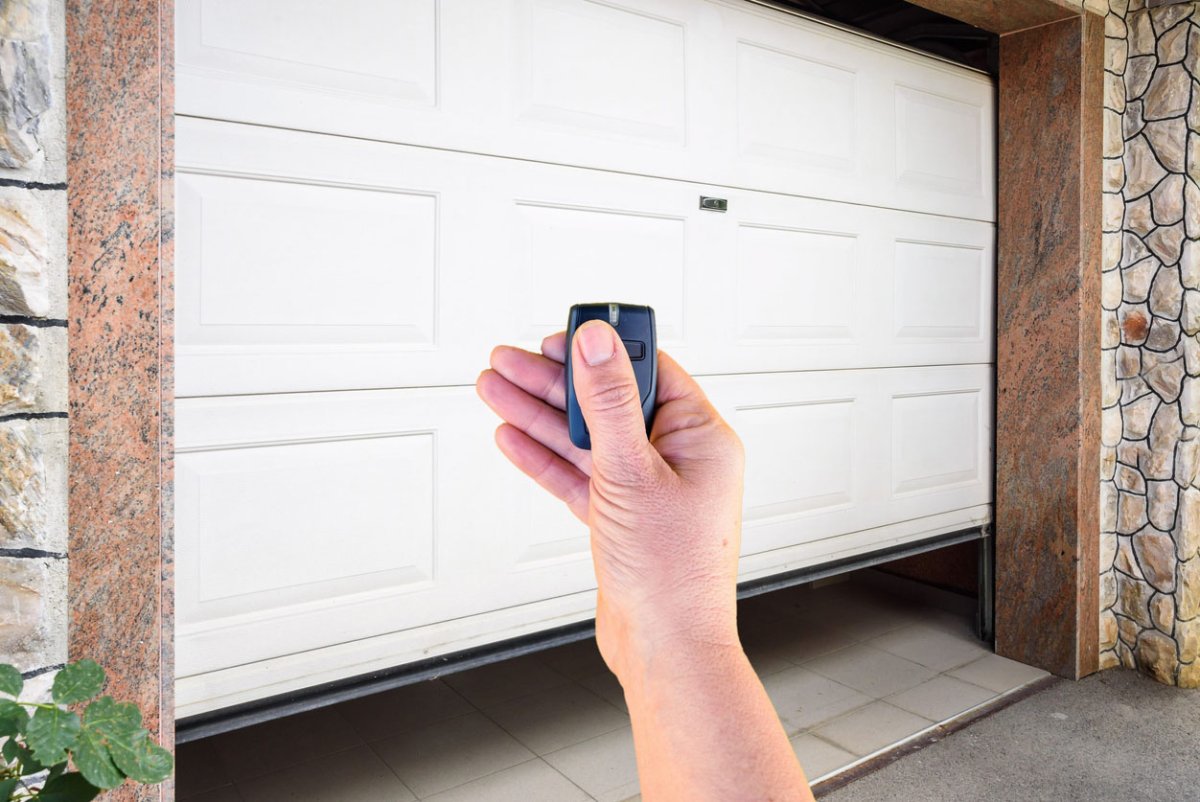
Types of Garage Doors
Homeowners have several options of garage door styles to choose from. On average, a new garage door costs between $400 and $8,000, depending on the materials and design style. The most common garage door type is sectional, which is a door with hinged panels that roll over a track. Other options include carriage house, French, glass or metal roll-up, tilt-up, and walk-through.
| Garage Door Type | Average Cost (Door Only) |
| Carriage house | $1,200 to $8,000 |
| French | $2,000 to $6,000 |
| Glass roll-up | $1,000 to $7,000 |
| Roll-up | $600 to $3,000 |
| Sectional | $500 to $1,800 |
| Tilt-up | $400 to $1,600 |
| Walk-through | $700 to $6,000 |
Carriage House
Carriage house doors are ideal for traditional and historic homes, as they emulate an older style. They can also offer an upscale and elevated look on modern homes. While the look of this garage door style can vary, the price typically falls between $1,200 and $8,000.
French
French garage doors are relatively rare but can be just the style needed to provide a home with a touch of elegance. Like French doors in a home, they feature double doors that swing outward and sometimes have windows on the upper portion of the door. These garage doors cost $2,000 to $6,000.
Glass Roll-Up
While they may not be practical for the average garage, glass roll-up doors are a great addition to structures where homeowners would like to let in lots of natural light. They are popular for sunrooms, pool houses, and commercial properties like restaurants and event spaces. Glass garage doors cost between $1,000 and $7,000.
Roll-Up
Roll-up garage doors conserve the most space, as they’re designed to wrap themselves onto a bar rather than being pulled flush to the garage ceiling. They are typically made of aluminum, steel, wood, or fiberglass that is sectioned to be tightly rolled. Roll-up doors don’t paint or upgrade well once installed, but they are durable and low maintenance. The average cost of roll-up garage doors is $600 to $3,000.
Sectional
The most popular garage door style is sectional. It is reliable and requires minimal space. It’s constructed with four to six hinged panels that allow the door to roll on a wide track to the top of the garage. They usually come with rubber seals on the edges to help with energy efficiency. Sectional garage doors typically cost between $500 and $1,800. A repair person can install garage door replacement panels if any sections become damaged.
Tilt-Up
Tilt-up canopy doors are made of one solid material that lifts the door to the garage ceiling with two gear hinges on either side. The door swings out toward the driveway while opening and extends over the garage, spreading like a canopy when fully open. This style is a little noisier when opening and closing. The average cost of this tilt-up canopy style is $400 to $1,600.
Walk-Through
Walk-through garage doors are standard garage doors with a smaller door for entry on foot set within it. This garage door type is perfect for small garages that don’t have the wall space to accommodate a front door elsewhere. Walk-through garage doors range from $700 to $6,000.
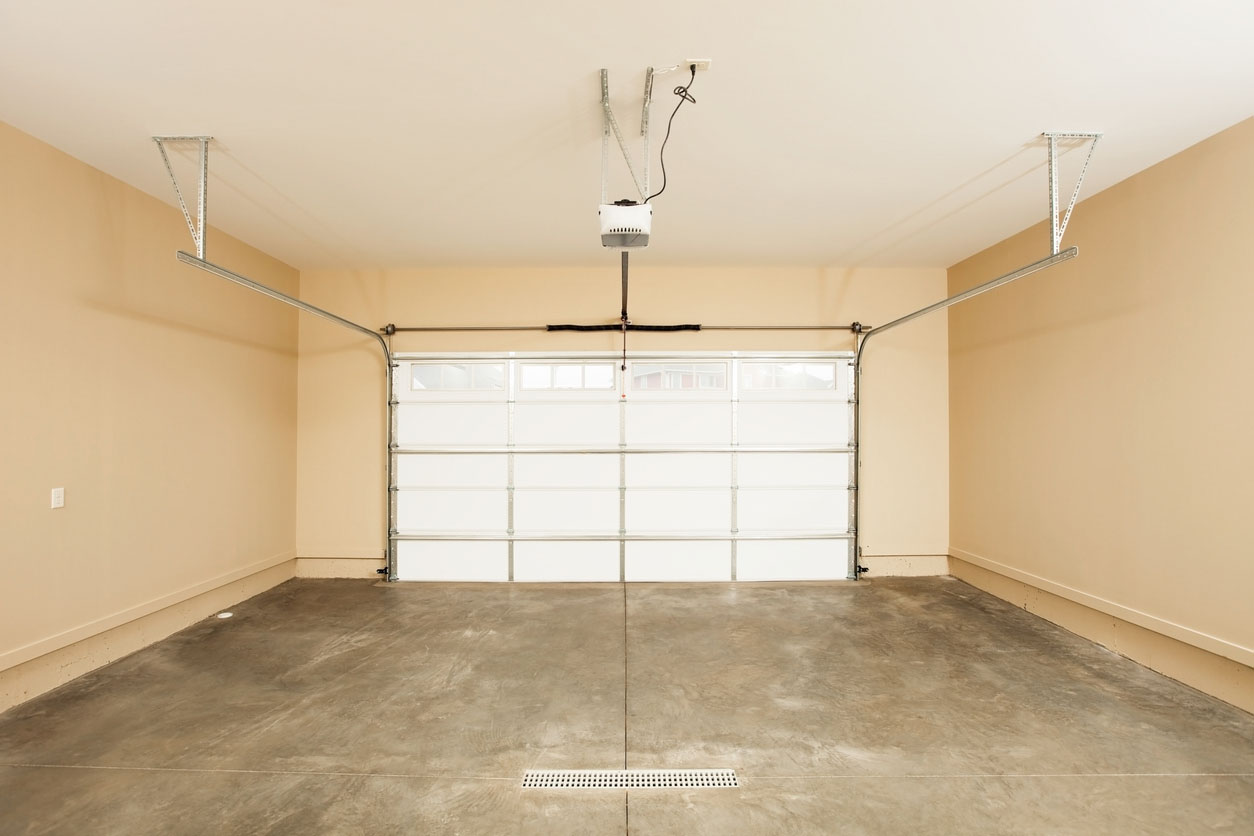
Do I need to replace my garage door?
On average, a garage door will last approximately 30 years if properly maintained. So how do homeowners know when it’s finally time for replacement? According to Russell, the answer “usually comes down to the appearance of the door. If the customer is satisfied with the current design, repairing the door would be the best solution. However, there are instances where the door may appear fine but lacks structural integrity, necessitating replacement for safety reasons.” The following issues are a good indication that the current garage door is nearing the end of its life.
Physical Damage
If a garage door has been physically damaged by a car, object, or storm, it needs to be replaced. Although a garage door isn’t the primary feature of a home, it will likely be noticeable by passersby and potential home buyers. Unless a homeowner knows how to fix a broken garage door or is willing to pay for extensive repairs, the door will need to be replaced. If the damage was caused by an unexpected occurrence such as vandalism or a storm, it’s worth a homeowner looking into whether their homeowners insurance covers the garage.
Excessive Noise
A garage door that squeaks, shakes, or rumbles is an annoyance; not only that, it can also mean that the door is going to give out sooner rather than later. While a few minor repairs or one of the best garage door lubricants may slightly improve the noise problem, they will likely only delay the inevitable. If the entire neighborhood can hear when the garage door opens, it’s time for the homeowner to consider replacement.
Operational Difficulties
Is the garage door getting stuck on its way open or closed? Does it jerk or shake while in motion? This is another sign that a garage door replacement is needed in the near future. Alternatively, it could be a sign that a homeowner needs to budget for garage door spring replacement costs if a full replacement isn’t needed. The sooner the problem is fixed, the less time will be wasted sitting in the driveway waiting for the garage door to move.
Aging
If a garage door isn’t correctly maintained, it is more susceptible to weathering and breaking down. A door that’s rotted, cracked, or corroded needs replacement—not just for curb appeal but also for safety reasons. Older garage door parts can break if they haven’t been regularly inspected and maintained. If the entire garage is also looking worse for wear, it could be worth a homeowner looking into the cost to build a new garage.
Poor Security
An old garage door is often easier for thieves to break or pry open than a new one. Replacing the garage door will help protect any belongings that are kept in the garage, especially if a few extra security features are added. This will be a particularly high priority for owners of attached garages since entry to the garage provides access to the home itself.
Poor Energy Efficiency
Homeowners who spend a significant amount of time in their garages working on their cars or doing other projects may have heating or air conditioning installed in the space. Older garage doors tend to be less energy efficient, resulting in both higher energy costs and more uncomfortable garage conditions. Replacing the garage door with a more energy-efficient model can make spending time in the garage year-round a more pleasant and affordable possibility.
DIY vs. Hiring a Professional
Choosing a garage door can be a daunting task. An easy way to get started is to browse Home Depot garage doors or Lowe’s garage doors to see what kind of installation kits are available. Even for a more straightforward style like a single-panel door, a DIYer would need help to manage the heavy door. Installing a new garage door isn’t a one-person job, even for professional garage door installers.
The springs used to lift and lower the door are under extreme pressure and must be handled cautiously to avoid injury. For this reason, it’s best for a homeowner to leave the heavy lifting to the pros. Russell agrees. “A homeowner could do the job, but most of the time, they do not have the proper training to get the door installed properly. Additionally, the store-bought version of most garage doors is not up to the same standards as a professionally installed garage door model,” he says.
Since garage door replacement cost is primarily materials rather than labor, using a professional garage door installation company gives most homeowners an 85 percent return on their investment. For an average cost of $350 for labor, a new garage door installation can be completed safely and quickly. Look up “garage door replacement near me” to find a qualified local professional.
How to Save Money
Buying a new garage door doesn’t have to be a costly process. For instance, customization is the primary way to increase the cost of a replacement garage door, but standard doors are designed to suit most homes at a great value. Homeowners who are ready to install a new garage door but don’t want to overspend can consider these tips for how to save money on garage door replacement costs.
- Purchase the door yourself. Purchase directly from the manufacturer for the lowest price, then hire an experienced independent contractor to install the door.
- Keep it simple. Choose a basic door style rather than adding windows or custom designs. Any working garage door is better than a damaged one in terms of curb appeal.
- Skip the add-ons. Decide which add-on features you can’t live without, such as automatic or insulated, and forgo any extras that don’t fit the budget, such as smart technology or double-steel backing.
- Check the warranty. Install a door that comes with a warranty to avoid a problem with a potentially defective door down the road. Some warranties also offer discounts on repairs from the installation company.
- Keep up with maintenance. Regularly maintaining your garage door will help prevent the need for sudden repairs or replacement in a short time frame.
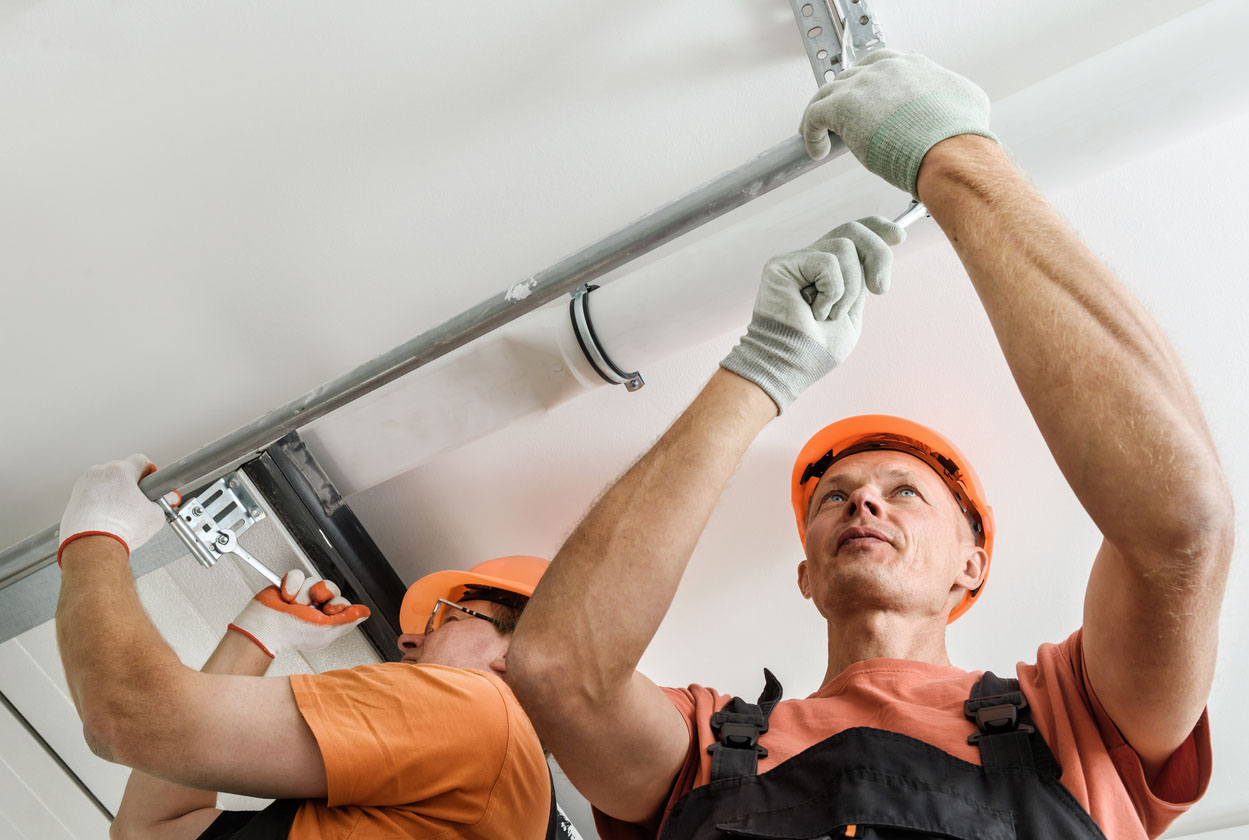
Questions to Ask a Pro
As with any large purchase, homeowners want to feel confident in their purchase, avoid miscommunication, and get their desired result. There is no one-size-fits-all with garage door choices. After a homeowner searches “garage door installation near me” and finds their local pro, they can ask the following questions.
- What’s the best kind of material for a garage door in my area?
- Do I need to resize my garage door if I’m upgrading it?
- Can I simply upgrade my manual door to an automatic door?
- How much will insulating my garage door save me over time?
- I need a third garage door that’s higher than my other two. How much more will that door cost?
- What will it cost to customize the design of my garage door to match my house?
- Will you remove an existing broken garage door, and if so, how much does it cost?
- Do you offer any manufacturer discounts?
- How much do extra garage door openers cost?
- Can this style of garage door have a lock installed as well?
- How much do you charge for labor?
- Are you licensed and insured?
- How long will it take to install my garage door?
- Do you offer a warranty?
- What steps can I take to protect my investment in a garage door?
- What do you charge if I have a problem with my garage door down the road?
FAQs
Garage door replacement cost doesn’t have to be a mystery or challenging process. The following are some frequently asked questions to help guide homeowners through the process.
For a replacement installation, the existing garage door parts will need to be inspected to determine which hardware pieces can be reused or replaced. Once the new parts and door are ordered, a garage door specialist team will install all the necessary parts to get the garage door system running again. This may include new tracks, springs, and wires, depending on the door type. The doors will be carefully leveled while being hung to avoid stressing or damaging the door or door parts over time.
For a new installation, homeowners will need to know the dimensions of the opening for the door and decide which type they prefer (tilt-up, sectional, or another kind). Once the kit is selected, a team of qualified professionals can install the materials, hardware, and door, set up the motor, program the remotes, and check that it’s safely operating.
The national average cost to install a new garage door is $2,500. This price varies by region, the number of doors being installed, door materials, type of door, and any customizations you prefer. Labor costs average about $350 for two garage door installers working together. The style of the door does not affect the amount of labor, only the number of doors. The average cost of a single garage door is between $1,500 to $6,000, depending on if the doors need to be oversized or highly customized to match the house’s exterior.
A 2-car garage door, or double bay, could cost between $800 and $4,900, including installation. Customization will push the price to the higher end of that range. These openings are usually 15 to 17 feet wide.
A popular design for new homes is the carriage style which opens outward rather than shifting to the top of the garage. These are usually designed with wood and custom beams or wrought-iron designs to suit the house style. On average, carriage garage doors cost between $1,200 to $8,000.
The cost of changing a manual garage door to an automatic garage door depends on what kind of door is already installed. Some types of doors may not upgrade as easily as others will. On average, adding an automatic motor to a garage door will increase the overall cost by $200 to $1,300. If a homeowner is considering selling their property, it pays to get a new garage door.
Sources: Angi, HomeAdvisor, Fixr
